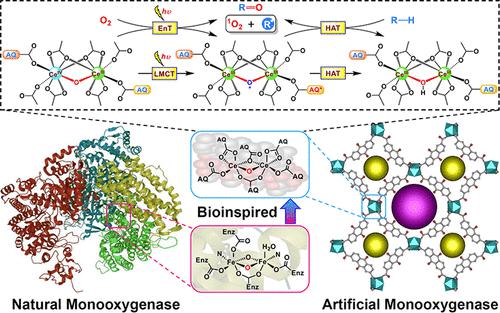当前位置:
X-MOL 学术
›
ACS Catal.
›
论文详情
Our official English website, www.x-mol.net, welcomes your
feedback! (Note: you will need to create a separate account there.)
A Binuclear Cerium-Based Metal–Organic Framework as an Artificial Monooxygenase for the Saturated Hydrocarbon Aerobic Oxidation with High Efficiency and High Selectivity
ACS Catalysis ( IF 11.3 ) Pub Date : 2022-06-17 , DOI: 10.1021/acscatal.2c01030 Guanfeng Ji 1 , Liang Zhao 1 , Yefei Wang 1 , Yang Tang 1 , Cheng He 1 , Songtao Liu 1 , Chunying Duan 1
ACS Catalysis ( IF 11.3 ) Pub Date : 2022-06-17 , DOI: 10.1021/acscatal.2c01030 Guanfeng Ji 1 , Liang Zhao 1 , Yefei Wang 1 , Yang Tang 1 , Cheng He 1 , Songtao Liu 1 , Chunying Duan 1
Affiliation

|
Artificial enzymatic systems have emerged in the field of biomimetic catalysis by constructing specific catalytic centers of enzymes. Inspired by the high activity of natural monooxygenase for the oxidation transformation, several binuclear Cu/Fe-based metal–organic frameworks (MOFs) have been frequently used as oxidation catalysts, yet rarely reports of MOFs with other metals nodes have been reported to date. In this work, by the ingenious decoration of binuclear Ce–O–Ce moieties and anthraquinone groups with good oxygen activation ability in one framework, an MOF-supported artificial binuclear cerium monooxygenase was obtained for the highly selective oxidation of inert C(sp3)–H bonds. The single-crystal structural study reveals that the molecule-level modularity with a binuclear Ce–O–Ce moiety design in the MOF creates a confined microenvironment to offer the ordered distribution of highly dense substrate-accessible active sites throughout the architecture. After photoexcitation, the Ce–O–Ce moieties trigger a ligand-to-metal charge-transfer (LMCT) event to form an oxygen bridge radical, which abstracts a hydrogen atom from the C(sp3)–H bond to generate a carbon-centered radical through a typical hydrogen atom transfer (HAT) process. These carbon-centered radicals rapidly combine the reactive oxygen species (ROS) produced by the anthraquinone groups via an energy transfer (EnT) process to generate the alkyl peroxy radical intermediates, which are easily trapped by another unsaturated coordinated cerium ions to further facilitate their hydrolysis for the selective formation of carbonyl products. This anthraquinone-functionalized metal–organic framework containing binuclear cerium catalytic centers resembling the active sites of natural monooxygenase exhibits the unique catalytic selectivity (>97%) and high activity, which represent the first example of the MOF constructed from metals different from that of natural monooxygenase for applying to the oxidation of alkanes, expanding the selection range of metal centers in the artificial monooxygenase. Taking advantage of the heterogeneity of the MOF, the Ce–MOF was recycled five times without a decrease in its selectivity and activity and possessed broader applicability for the substrate with inert C–H bonds, providing a blueprint for designing new artificial monooxygenase for the inert alkane oxidation.
中文翻译:

双核铈基金属有机骨架作为人工单加氧酶用于饱和烃好氧氧化的高效率和高选择性
通过构建特定的酶催化中心,在仿生催化领域出现了人工酶系统。受天然单加氧酶对氧化转化的高活性的启发,几种双核 Cu/Fe 基金属有机框架 (MOF) 经常用作氧化催化剂,但迄今为止很少报道 MOF 与其他金属节点的报道。在这项工作中,通过在一个框架中巧妙地修饰双核 Ce-O-Ce 部分和具有良好氧活化能力的蒽醌基团,获得了一种 MOF 负载的人工双核铈单加氧酶,用于高选择性氧化惰性 C( sp 3)–H 键。单晶结构研究表明,MOF 中具有双核 Ce-O-Ce 部分设计的分子级模块化创造了一个受限的微环境,从而在整个架构中提供有序分布的高密度底物可访问活性位点。光激发后,Ce-O-Ce 部分触发配体-金属电荷转移 (LMCT) 事件,形成氧桥自由基,从 C( sp 3)–H 键通过典型的氢原子转移 (HAT) 过程生成以碳为中心的自由基。这些以碳为中心的自由基通过能量转移 (EnT) 过程快速结合蒽醌基团产生的活性氧 (ROS) 生成烷基过氧自由基中间体,这些中间体很容易被另一种不饱和配位铈离子捕获以进一步促进其水解用于选择性生成羰基产物。这种蒽醌功能化的金属有机骨架含有类似于天然单加氧酶活性位点的双核铈催化中心,具有独特的催化选择性(>97%)和高活性,代表了第一个由不同于天然金属的金属构建的 MOF。用于烷烃氧化的单加氧酶,扩大了人工单加氧酶中金属中心的选择范围。利用 MOF 的异质性,Ce-MOF 可循环 5 次而不降低其选择性和活性,对具有惰性 C-H 键的底物具有更广泛的适用性,为设计新的惰性单加氧酶提供了蓝图。烷烃氧化。
更新日期:2022-06-17
中文翻译:

双核铈基金属有机骨架作为人工单加氧酶用于饱和烃好氧氧化的高效率和高选择性
通过构建特定的酶催化中心,在仿生催化领域出现了人工酶系统。受天然单加氧酶对氧化转化的高活性的启发,几种双核 Cu/Fe 基金属有机框架 (MOF) 经常用作氧化催化剂,但迄今为止很少报道 MOF 与其他金属节点的报道。在这项工作中,通过在一个框架中巧妙地修饰双核 Ce-O-Ce 部分和具有良好氧活化能力的蒽醌基团,获得了一种 MOF 负载的人工双核铈单加氧酶,用于高选择性氧化惰性 C( sp 3)–H 键。单晶结构研究表明,MOF 中具有双核 Ce-O-Ce 部分设计的分子级模块化创造了一个受限的微环境,从而在整个架构中提供有序分布的高密度底物可访问活性位点。光激发后,Ce-O-Ce 部分触发配体-金属电荷转移 (LMCT) 事件,形成氧桥自由基,从 C( sp 3)–H 键通过典型的氢原子转移 (HAT) 过程生成以碳为中心的自由基。这些以碳为中心的自由基通过能量转移 (EnT) 过程快速结合蒽醌基团产生的活性氧 (ROS) 生成烷基过氧自由基中间体,这些中间体很容易被另一种不饱和配位铈离子捕获以进一步促进其水解用于选择性生成羰基产物。这种蒽醌功能化的金属有机骨架含有类似于天然单加氧酶活性位点的双核铈催化中心,具有独特的催化选择性(>97%)和高活性,代表了第一个由不同于天然金属的金属构建的 MOF。用于烷烃氧化的单加氧酶,扩大了人工单加氧酶中金属中心的选择范围。利用 MOF 的异质性,Ce-MOF 可循环 5 次而不降低其选择性和活性,对具有惰性 C-H 键的底物具有更广泛的适用性,为设计新的惰性单加氧酶提供了蓝图。烷烃氧化。











































 京公网安备 11010802027423号
京公网安备 11010802027423号